A sobering artistic meditation on Indigenous lives lost while in police custody links the work of more than 30 contributors with a common message: there is power in speaking names and sharing stories. Independent researcher Leonard Cler-Cunningham, who in 2023 launched a website to compile in-custody deaths, opened the exhibition Not in the Public Interest on Feb. 14 at the Sunshine Coast Arts Centre.
“It’s heavy, but there’s lots of beautiful intent,” said participating textile artist Maddy Andrews, from Vancouver. “And there are trickster stories, too, that are uplifting efforts at survival.”
While introducing his sweeping fusion of art and activism, Cler-Cunningham noted the show’s synchronicity with another collection that opened across the gallery: Black Lines, the debut solo exhibition of Toronto-based painter Crystal Ali. “I’m not an artist,” Cler-Cunningham admitted, “but from the margins I get to look over and [observe] the consequence of when identity and worth are externally imposed, and you don’t get to define who you are and what you’re worth.”
Issues of judgement and coercion are woven (sometimes literally) through the works created by Cler-Cunningham’s international cohort. Handloom weavings by Maddy Andrews depict urban streetscapes pivotal to the story of Alfred Richard Mountain, who died in November 1983. Intricate miniatures by David Goodwin freeze time, illustrating unnerving scenes with pipe cleaner figurines.
Seven short video documentaries offer atmospheric depictions of injustices that originally received limited attention by news media and authorities. The names and details of those who died in custody are emblazoned high on the walls, compelling viewers to raise their eyes in an attitude of reverence.
Words scrawled between defiant legs in an oil painting by Dhanmite Hartman commemorate the violent death of Ida King in Williams Lake: “Ida was beaten to death by her husband... while passerbys [sic], some of whom testified to the sight of an Indian woman being beaten wasn’t at all unusual, looked the other way.”
The exhibition’s title stems from a legal principle that Cler-Cunningham encountered when seeking the release of records for a CBC-funded documentary. “If you do an FOI [freedom of information request], it’s based on the state of public interest,” he said, “which is understood as this: if I stopped 10 people in the street, would the issue matter to them? Would they care?”
A mask carved from red cedar by Sechelt-based Homalco Nation artist Derek Georgeson incorporates copper and human hair to amplify the defiant message carved at its base: “No more stolen sisters,” a reference to missing and murdered women and girls. A crimson handprint covers the solemn figure’s mouth.
A mixed-media diptych by Sandra Yuen uses vivid abstract motifs to reflect the energy of Harriet Nahannee, a Pacheedaht Nation activist who died in 2007 after imprisonment; she had been sentenced for contempt of court related to her opposition of the Sea-to-Sky highway expansion. (The provincial government later refused requests for an inquiry.)
“The goal,” added Cler-Cunningham, “is this: for British Columbia to move from being an embarrassment to becoming world leaders.” He cited the need for increased civilian oversight for police treatment of Indigenous people. “That’s our motivation for the next step,” he said, expressing the hope that the show will tour to other galleries and communities. “This is what art is supposed to be like, the nexus of creativity and political [action].”
Meanwhile the muscular, iconographic canvases by Nigerian-born Crystal Ali in Black Lines project unflinching confidence in the power of cultural identity. “These paintings explore moments of realization, of resistance, and resilience,” she said. In nuanced oil-and-acrylic paintings like fur coat, she explores the complex convergence of beauty, tradition and consumerism. In why are you crying?, catharsis courses through its ultramarine colour palette and intricate graphic language. Throughout the series, complex symbology appears alongside deconstructed aspects of human physiognomy.
“I don’t really paint to provide answers,” she said. “I paint to capture emotions, and the reality of all our emotions is that they’re not always resolved neatly.”
The two shows — Black Lines and Not in the Public Interest — remain on display at the Sunshine Coast Arts Centre until March 15.



